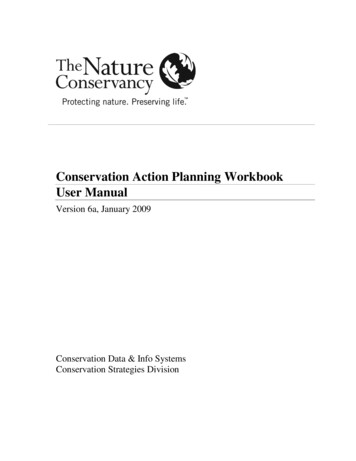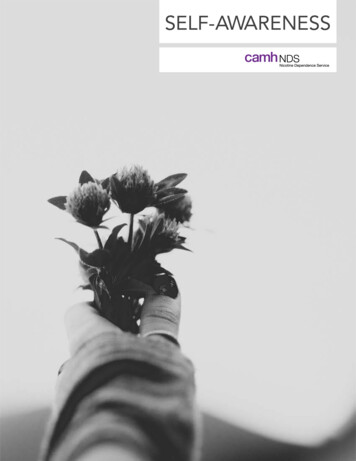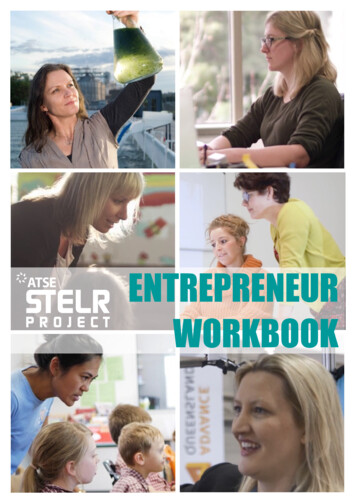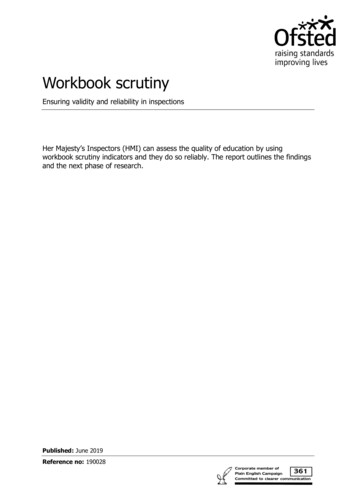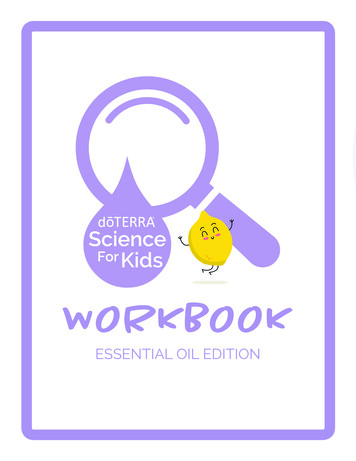
Transcription
WORKBOOKESSENTIAL OIL EDITION
Welcome todōTERRA Science for KidsCuriosity is a natural part of life for children. The dōTERRA Science forKids program seeks to encourage this fundamental love of exploration.Our resources can be used at home and in the community to learn moreabout the world through scientific discovery. By partnering this workbookwith dōTERRA Science for Kids online content, you will find the tools tohelp your little scientists foster a love of science and build knowledge inbasic chemistry, essential oils, and health.dōTERRA Science for Kids seeks to promote science education forchildren of various ages worldwide by encouraging curiosity, exploration,and discovery. We accomplish this by: Providing tools and resources that enable parents to help theirchildren learn about science at homePresenting scientific lessons in our local community, both atschools and here at dōTERRA campusDonating to schools and scientific programs through the dōTERRAHealing Hands Foundation dōTERRA Science for Kids offers scientific modules, experiments, andactivities that can be enjoyed by children of all ages. As you use theseresources, keep in mind: Before beginning any experiment or activity, make sure to haveappropriate adult supervision. Some experiments involve heat orsharp objects, which must be used with care.When cooking, make sure to follow proper hand-washingguidelines. Tip for parents: dōTERRA On Guard Foaming HandWash is a great product to use when working in the kitchen!Enjoy!1
What’s Inside?Table of Contents1. Meet the Plants! . . . . . . . . . . . . . . . . . . . . . . . . . . . . 32. What Is Science?. . . . . . . . . . . . . . . . . . . . . . . . . . . . 4a. The Scientific Method . . . . . . . . . . . . . . . . . . 6i. Scientific Method Experiment . . . . . . 8b. Coloring Page: Laszlo the Lemon . . . . . . 112. What Is an Essential Oil? . . . . . . . . . . . . . . . . . . . . 12a. Secret Message Activity . . . . . . . . . . . . . . . 153. Distillation: Making Essential Oils . . . . . . . . . . . 17a. Steam Distillation . . . . . . . . . . . . . . . . . . . . . . 18b. Expression (Cold Pressing) . . . . . . . . . . . . . 19c. Solvent Extraction . . . . . . . . . . . . . . . . . . . . . 19i. Distillation Experiment . . . . . . . . . . . . . 21ii. Distillation Crossword . . . . . . . . . . . . . 25d. Coloring Page: Charlie Cinnamon . . . . . . 264. Essential Oil Use and Safety . . . . . . . . . . . . . . . . 27a. Application Methods . . . . . . . . . . . . . . . . . . 28i. Use and Safety Crossword . . . . . . . . 31ii. Essential Oil Tips for Kids . . . . . . 335. Organaleptic Testing . . . . . . . . . . . . . . . . . . . 34a. Coloring Page: Perry Peppermint . . 394. Additional Activities . . . . . . . . . . . . . . . . . . . 40a. Essential Oils and Emotions . . . . . . . 41b. Aromas Experiment . . . . . . . . . . . . . . . . . 46c. Essential Oil Word Search . . . . . . . . . . . 50d. Create Your Own Blend . . . . . . . . . . . . . 522
Meet the Plants!gthwe GEranpefruitrthieTRAoseREXthe RoselIEkchAmRon Sticthe CinnaPPEeprperrmYint LeaflAthesLzemLoonthePETrAcEcEOtheLLOraIEngepAT3
What Iis Science?You learn about it in school, watch videos about it, and maybe even do sciencee peri ents on your own ou ay ha e heard that d is a science based company. . . but what is science, exactly?ScienceScienceis a branchof knowledgeor athatstudythat usesis a branchof studyor knowledgedealswith information (also(alsoknown as facts) gained about the natural world through experimentsand observations.howpeoplepeople learnlearn about the ut si ply science andand scientificscientific studystudyareis hownatural world. It’s because of science that we know how plants get theirfood, how weather is made, and how the human body works.Why is science important?How do you use science in your life?Science in HistoryScience has played a key role throughout humanhistory. Many important discoveries were madehundreds, even thousands, of years ago. For example, in 1543, Nicholas Copernicus publishedhis theory that the sun is at the center of the solarGravitywaswasdiscoveredbybySirSirIsaacsystem. AndgravitydiscoveredIsaacNewton in 1666. History is full of amazing scientific disco eries and the cool thin about scienceis that there is always more to learn and discover!Once one question gets answered, it opens thedoor to ask hundreds more, making it possiblefor scientists to continue learning as they conduct e peri ents usin the scientific ethod Cool ScientistDid you know that AlbertEinstein, one of the mostfamous scientists of allti e first beca e interested in science becauseof a compass? His fathergave it to him as a gift andhe wanted to fi ure outhow it worked.NEWS4
)MǺIVIRX 'VERGLIW SJ GMIRGI åÏ ƚŸå ƋĘåųå ĜŸ ŸŅ ĵƚÏĘ ƋŅ Ĭå ųĹØ ŸÏĜåĹƋĜŸƋŸ ŅüƋåĹ ŞĜÏĩ ŅĹå ŸŞåÏĜĀÏ ƋĘĜĹč ƋŅ ŸƋƚÚƼţ Ęåųå ųå ĬŅƋ Ņü ÚĜýåųåĹƋ ĀåĬÚŸ ĜĹ ŸÏĜåĹÏå ĹÚ å ÏĘ ÏŅĹƋųĜÆƚƋåŸ ƋŅ Ņƚų ƚĹÚåųŸƋ ĹÚĜĹč Ņü ƋĘå ƵŅųĬÚ ųŅƚĹÚ ƚŸţ e üåƵ ĀåĬÚŸ Ņü ŸÏĜåĹƋĜĀÏ ŸƋƚÚƼ ĜĹÏĬƚÚå ÆĜŅĬŅčƼØ Ęå ĬƋĘ ŸÏĜåĹÏåØ ĹÚ ÏĘåĵĜŸƋųƼţIf you were a scientists,, what would you OGYICSSYPHSTRYCHEMISCIENCEScience Iis Cool ÏĜåĹƋĜŸƋŸ ŸƋƚÚƼ ĬĵŅŸƋ åƴåųƼƋĘĜĹčú Ęåųå ųå ŸŅ ĵ ĹƼ ÚĜýåųåĹƋ Ş ųƋŸ Ņü ŸÏĜåĹÏå ƋĘ Ƌ ƼŅƚ Ï Ĺ åƻplore. Find what interests you and start asking questions. There is so much to learn about the worldand science is a great place to start. This workbook just scratches the surface of science, but it canbe an excellent tool to help you learn more about the world and how it works.5
8LI GMIRXMǻG 2IXLSH ÚåžƐžƒåŤžƐƒĚ ƒƐĚåĮŤƐDžŇƣƐĀĻÚƐ å ÏĚƐžƒåŤƐžŇƐƒĚ ƒƐŇƒĚåŹƐŤåŇŤĮåƐÏ ĻƐŹåŤå ƒƐDžŇƣŹƐåDŽŤåŹĞķåĻƒƐ ĻÚƐƒåžƒƐDžŇƣŹƐĀĻÚĞĻďžũ?Step 1: Ask a QuestionEvery science experiment begins with a question--somethingyou want to—Ĭå ųĹ Ņų åƻŞĬ ĜĹţ kĹÏå ƼŅƚ Ę ƴå ŧƚåŸƋĜŅĹØ ƋĘå ŸÏĜåĹƋĜĀÏ ĵåƋĘŅÚ Ï Ĺ ĘåĬŞ ƼŅƚ ĀĹÚ ƋĘå ĹŸƵåųúWrite down one question you’d like to answer:Step 2: Background Research ÏĩčųŅƚĹÚ ųåŸå ųÏĘ ĘåĬŞŸ ƼŅƚ ĀĹÚ åƻŞåųĜĵåĹƋŸ ŅƋĘåų ŞåŅŞĬå Ę ƴå ÚŅĹå to answer the same or similar questions and helps you understand the basicscience surrounding your question.What information should you look for when doing research?What resources could you use to help you research?Step 3: Form a HypothesisA hypothesis is a prediction or an educated guess based on your researchand previous knowledge. It is when you guess what you think is the answerto your question.How do you develop a hypothesis?6
Step 4: ExperimentAn experiment is a step-by-step procedure you follow to see if your hypothesisis right or wrong. As you conduct your experiment, make sure to record yourresults and observations so that you have information to review as you analyzethe experiment in the next step.List an experiment you’ve done before or one that you think would be fun to do.Step 5: AnalysisOnce you have completed your experiment, you will need to review (alsoknown as analyze) the results. Analysis looks for patterns or broken patternsĜĹ ƼŅƚų ĀĹÚĜĹčŸţWhy is it important to analyze your results?Step 6: ConclusionIn your conclusion, you will summarize your experimentand share what those results mean for your hypothesis.Why do you think a conclusion is important?Step 7: Share Your Results Ęå ĀĹ Ĭ ŸƋåŞ Ņü ĹƼ åƻŞåųĜĵåĹƋ ĜŸ ŸĘ ųĜĹč ƼŅƚų ųåŸƚĬƋŸ ĹÚ ÏŅĹÏĬƚŸĜŅĹţ Ęå knowledge gained in conducting an experiment can help others as they workto learn more about the world that surrounds them.How will you share your results as you conduct experimentsat home? Why is sharing results important?7
Scientific Method ExperimentFor this experiment, you will be using the scientific method to answer the following question:Which essential oil has the greatest density: Wintergreen, Cinnamon, or Lemon? Part of thescientific method is background research. For this experiment the background you need toknow is that oil doesn’t mix with water and the densest oil will sink in the water.What You’ll Need: 3 transparent cups(smaller cups work better because it’s easier to see wherethe oil is without having to use a lot of water or essential oil) A spoon Water Wintergreen essential oil Cinnamon essential oil Lemon essential oil Tape A marker Ask a parent or adult before using the essential oils in this experiment.What You’ll Do:1. Before beginning the experiment, take a moment to write down your hypothesison question 1 of your “What You Discovered Worksheet.”2. Using the tape and marker, label each cup with either Wintergreen, Cinnamon,or Lemon so that you can keep track of which oil you will put in each cup.3. Next, fill each cup up with water.4. Start with Lemon essential oil and drop several drops of essential oil into thecup labeled lemon. You want to put in enough oil that you can see it in the water.5. Answer question 2 on your “What You Discovered” worksheet.WinTErgrEEnciNNAmoN8
6. Repeat step 5 for both Cinnamon and Wintergreen essential oils, taking timeto answer questions 3 and 4 on your “What You Discovered” worksheet.7. Complete your worksheet, answering questions 5-8 to write your conclusion.8. Once you’re done filling out your worksheet, add your water and oil mixturesto a diffuser so that you can enjoy the aromatic benefits of these essential oils.!ogoWay TWhat Does It Mean:Adjusting one variable in an experiment allows you to see changes and link thosechanges to one cause. By changing the essential oil added to a glass of water you areable to directly compare which essential oil is most dense.Changing only one variable is key to the scientific method. The scientific method allowsyou to find answers to a wide range of questions in all disciplines of science. This appliesto physics, chemistry, and all other areas of science. The scientific method is an importantpart of learning and discovery as people continue to investigate the world around them.What to Do Next:Repeat this experiment, but use different essential oils to learn their density and howthey compare to each other.With your parent’s permission, share your results and photos of your density experimentonline using the hashtag #doterrascienceforkids.You’re on Your wAy TobEcOming A ScIEnTIsT.9
What You Discovered1. Which essential oil do you think will be the densest?Lemon, Cinnamon, or Wintergreen?2. Where does the Lemon essential oil rest in the water?Is it on top of the water? Under the water? Level with the water?3. Where does the Cinnamon essential oil rest in the water?4. Where does the Wintergreen essential oil rest in the water?5. Compare all three glasses. Which essential oil is the densest?(Hint: This oil will be the one that rests the lowest in the water.)6. Do the results match your hypothesis? Did you guess correctly?7. Why do you think the scientific method is important?8. What did you learn from following the scientific method?10
Color Laszlo the Lemon!11
What Is an Essential Oil?Besides a nice smell in a bottle, have you ever wondered what an essential oil is?The definition may sound a bit complicated at first. Don’t worry, we’ll break it down.An essential oil is a hydrophobic liquid that contains volatilearomatic compounds from the various parts of plants.Questions:What is your favorite essential oil?Why is it your favorite?Let’s Define “Hydrophobic”Essential oils are hydrophobic, which means they are repelled by water. If you try to mix an oilwith water, the oil will separate from the water instead of mixing in.Try this experiment: Pour a few drops of dōTERRA oil into a glass of water. Try to stir the liquids together with a spoon. Notice that they do not mix—even when you stir!Let’s Define “Volatile”Because essential oils are volatile, they can change their state of matter (solid, liquid, gas)quickly. This trait assists in the extraction of most essential oils, as they quickly change statesduring the distillation process.LIQUIDSOLIDGAS12
Let’s Define “Aromatic”Aromatic means that something has a distinct smell. For example, lavender plants are aromaticbecause their flowers have a specific floral, powdery scent. Each essential oil has its own aromathat is determined by the chemical makeup of the plant it comes from.Question:What are some of your favorite smells?Let’s Define “Compounds”A compound is a mixture of two or more elements, the purest form of a substance. Water isa well-known compound because it is a mixture of the elements hydrogen and oxygen.Essential oils are made of many different elements and molecules.Fun Fact!Not all compounds have a distinct smell. For instance, pure water doesnot smell much like anything. This is why essential oils are identified asAromatic compounds can come from many different parts of aplant, such as the flowers, seeds, roots, leaves, and stems. Forinstance, Wild Orange essential oil comes from the rinds of theoranges, while Petitgrain comes from the leaves and twigs, andNeroli oil comes from the flowers on the orange tree.WILD ORANGENEROLIPETITGRAIN13
Let’s ReviewEssential oils have been used for thousands of years in a variety of physical and emotionalapplications. dōTERRA continues to provide the purest and most potent essential oils that canbe used in skin care products, aromatherapy, food preparation, healthcare practices, and more.COOKINGHOW CAN IUSE OILS?WELLNESSAROMATHERAPYWhen you break it down, essential oils are not too difficult to understand after all! Once youunderstand what essential oils are and where they come from, you can begin to understand thecountless benefits we can receive from incorporating them into our daily lives.Question:What do you use oils for?14
Secret Message ActivityBreak the Code!There’s so much to learn about essential oils. Use this keyto break the code on the next page and learn a fun fact.adefhilmnoprstuvw15
,,,.,16
DistillationEssential oils come from tiny sacs on the surface and insides of a plant. So, how do you get it out?Extracting these oils requires a process called distillation.Distillation extracts the important parts (essential oils) from plant material.There are many forms of distillation. dōTERRA uses steam distillation,expression (also known as cold pressing), and solvent extraction.Fun Fact!It takes about 75 lemons to make one 15 mL bottle ofLemon essential oil. That’s a lot of lemons!Purity and Potency: The 3 FactorsThere are three important factors within the distillation process that may affect the quality orstrength of the substance that is distilled.1. Heat SourceIf the temperature is too low, the distillation process will not be effective. Ifit is too high, there is a risk of damaging the substances.2. TimeThe time needed to distill a substance can rangefrom a couple hours to over a day.3. PressureDifferent materials require different levels of pressure.Higher pressure means faster distillation. This saves time andmoney, but also requires careful monitoring, so the substance is not ruined.17
From Soil to Oil: The 3 MethodsMemory GameDo you remember the 3 main types of distillation dōTERRA uses? Circle them!steam distillationvacuum distillationphytonic processexpressioncarbon dioxide extractionenfleuragesolvent extractionpercolationfractional distillationAnswers: steam distillation, expression, and solvent extraction1. Steam DistillationThis is the most common method for collecting essential oils. In a special container called a“still,” water is heated to create steam. The steam moves through a chamber containing plantmaterial. This causes the essential oil sacs in the plant to burst, releasing the oil. The steamtransports the oil into a condensing tube where oil and water collect. Because oil and waterdon’t mix, the essential oil rests on top and is easily separated for bottling.IT LOOKSLIKE EROIL ANDWATEROILHEATWATER18
2. Expression (Cold Pressing)This method is used for citrus oils because it preserves the strong citrus scent of the fruit. Insidethe expression machinery there are several rotating cylinders with large graters attached (like agiant cheese grater). As fruit is added to the machine, the graters cut up the surface of the fruitcausing the essential oil sacs to break open and release oil. Water sprays over the fruit to collectthe oil, and the mixture is filtered using a centrifuge. A centrifuge is a machine that rotates at highspeed in order to separate different liquids or solids from each other.Test it Out! Remove the peel from an orange. Bend it between both hands so that the peel breaks. Notice a light mist come out of the peel. That is the essential oil!3. Solvent ExtractionThis is a little more complicated than the other two methods we’ve discussed, but it makes itpossible to obtain oil from extremely delicate plants, like jasmine flowers. Oil obtained throughsolvent extraction is different than other essential oils and has a special name: absolute.In solvent extraction, plant material is placed in a tray and washed with a special solvent. Asolvent is a liquid that can dissolve other substances, such as lipids found in oils. The solvent iscarefully selected to make sure that it does not change the aroma or properties of the absolute.The mixture is then filtered to remove the plant material which makes a thick, waxy substancecalled a concrete. A second solvent is used to separate the absolute from the concrete. Thesecond solvent is then removed, leaving behind a pure absolute. dōTERRA uses this methodwith only a few oils, such as Vanilla and Jasmine.19
Test it Out!I LOVEPLANTS. Find a container. Place rose petals, a split vanilla bean, or herbs inside. Add some Fractionated Coconut Oil to the plant material. Allow the plant material to soak for several weeks or months. Gently shake the container every few days to keep the mixture even. Keep the container out of direct sunlight and away from high heat. The resulting mixture is your own fragrance!Draw Something!What is your favorite plant? Draw it in the box.20
Distillation ExperimentWhat You’ll Need: 1 large glass bowl 1 small glass container(shorter than large glass bowl) plastic wrap a stone water something to contaminate your water(dye, salt, glitter, etc.)What You’ll Do:Look fora stone inyour yard!NOTE : If it is not sunny enough outside to complete this experiment, you can microwavethe large bowl of water for 2-3 minutes, before adding the small bowl and dye, glitter,etc. This will create steam and allow the clean water to separate from the dirty water.Use caution and have a parent help with handling hot materials.1Before beginning this experiment, take a moment toanswer question 1 on your “What You Discovered” worksheet.Also, be sure to get a parent’s help and permission beforegathering the supplies for this experiment.2To start, fill the large bowl about 1/3 of the way with water.NOTE : During this step, make sure thatthe rim of your small container isnot higher than the rim ofyour large bowl.21
3Contaminate your water! Add food dye, salt, glitter, or anysubstance you would like to make the water dirty. Once you arefinished, place the smaller glass in the middle of the bowl andtry notto spillplace the plastic wrap tightly over the large bowl.FooddyeGLITTERsALTsand4Next, place the stone on top of the plastic wrap directly above the smallglass. Make sure the plastic wrap is not touching the rim of the small glass.NOTE : Make sure that thestones are heavy enough tocreate a slight downwardslope in the center of theplastic wrap.5Put the bowl in an area that gets a lot of sunlight.Let the bowl sit for at least an hour in sunlight beforechecking it. Then check every 30 minutes. As you watchwhat happens, answer questions 2 and 3 on your “WhatYou Discovered” worksheet.6Take a moment to finish your “WhatYou Discovered” worksheet. Don’t forget toshare your findings with family and friends!22
What Does It Mean?As the temperature inside the bowl gets warmer, thewater evaporates and rises as a vapor until it hits theplastic wrap. Next, the water condenses and runs downinto the glass. The water in the glass should be clear,pure water. This is because you simulated a steamdistillation process. The high temperatures allowed thewater to separate from the substance you used tocontaminate your water and collect in the empty glass.What To Do Next:1www.doTErra .com/bLog-ScIEncERepeat this experiment with a differentcontaminant. For instance, if you used glitterthe first time, try the experiment again withfood dye. Do the results change?2Revisit the dōTERRA Science for Kidstab on the dōTERRA Science Blog for morefun science experiments and activities.3With a parent’s permission, post a picture of your experimenton Facebook or Instagram. Make sure to tag us @doterrascienceand use the hashtags #doterrascienceforkids and #featureme fora chance to be featured on the dōTERRA Science Facebook page.wE can’T wAiT TosEE your ExpErimEnT!23
What You Discovered1. Before you begin the experiment, review the “Distillation” module.2. What can the distillation process be used for?3. Temperature, pressure, and time can all affect distillation.Which factors are involved in this experiment?4. After an hour or so, observe the bowl.What do you see happening to the water?5. Identify which method of distillation this experiment used.6. What other items do you use that could possibly be distilled?You can look back at the distillation module if you need helpcoming up with ideas.24
Distillation CrosswordDown1. Essential oils are volatile,compounds.extraction.2. Absolutes are collected using3. The three types of distillation dōTERRA uses are steam distillation,, and solvent extraction.4. The process used to extract essential oils.6.distillation is the most common form of distillation andinvolves heating up water.Across.”5. Cold pressing is also known as7. doTERRA means “gift of the213456725
Fill in Charlie Cinnamon Stick!26
*WWIRXMEP 4MP 9WI ERH EJIX] EJI JSV XLI ;LSPI EQMP]Essential oils are powerful tools that can be used to support health and well-being. When properusage guidelines are followed, essential oils are safe for the entire family. But for kids, what arethose proper usage guidelines eep reading to find out &HYPX YTIVZMWMSRThe most important rule for kids when it comes tousing essential oils is to always have the help andsupervision of an adult. Before using any essentialoil, even if it’s one you’ve used before, make sureto talk to an adult aboutfirst. using the essential oil first.DosageDosage, which is how much of an essential oil you use at once, is a big part of using oils safely.Essential oils are concentrated plant extracts. If too much oil is used, they can cause your body toreact negatively. There are many things to consider when choosing the dosage of an essential oilapplicationmethod.hardtosuch as your age, weight,weight, overalloverall cationmethod,andThisthe makestype ofitoilbeingfind thecorrectdosefor toeveryone.used.Thismakesit hardfind the correct dose for everyone.To be safe, start with one drop of an essential oil. From there, you and your parent can decide if theoil had the e ect you wanted or if you need a second drop. sing small amounts multiple times aday is better than using a huge amount once a day.How do you make sure that you’re using the right dosage?What factors do you need to remember when determining dosage?27
&TTPMGEXMSR 2IXLSHWAnother important factor is how you apply the oil. There are three ways you can apply essentialoils: aromatically, topically, and internally. Choosing the right application method is important sothat you can get the bene t you want from the oil.Aromatic UseTopical UseAromatic use is when you breathe in an essential oil. This canbe done by opening the bottle and inhaling the aroma or iloilintointoaadiffuser.diffuser. UsingUsingplacing aafewan essential oil aromatically allows you to enjoy the smellof an essential oil while also in uencing your emotions andpromoting well-being.Topical application is usedwhen you want the oil to impacta speci c area. For instance, ifyour skin is feeling irritated, youmay want to apply a soothingessential oil, like Lavender, directly to that spot. ememberto always dilute withbeforeapplycarrieroilbeforeing oils applyingtopically. topically.Sensitive AreasWhen using an oil topically,do not apply oils to sensitive areas, such as your eyesor ears. Always wash yourhands after applying oils sothat you don’t accidently getoils in one of these sensitiveareas.Internal UseInternal application is whenyou swallow essential oils. Youcan do this by taking a capsule,cooking with essential oils, oradding essential oils to wateror juice. Taking an oil internallyallows the oil to enter directly into the bloodstream. Neveruse an essential oil internallywithout adult permission andsupervision.DilutionBecause essential oils areare soso concentrated,potent, mixing anessentialoilwithacarrieroil,like Fractionatedmixing an essential oil with a carrieroil, likeCoconutOil, helpslessenthat potency.FractionatedCoconutOil, decreasesthe This our skinconcentration.is ghelps protect your skin by reducing the riskyourskinabsorbthe oilbetter.essenfor skinirritationwhilealsoAlwayshelpingdiluteyour skintialoilsbeforeapplyingthemtoskin.absorb the oil better. Why is dilution so important? When should you dilute?28
Picking the Correct OilsBefore using essential oils it’s important to pick the correctessential oils. Some oils are mild, while others are strong. Asa kid, your skin tends to be more sensitive than an adult’sskin, so using milder oils, such as Lavender, Melaleuca, orFrankincense, is a good idea. Avoid using stronger oils likeOregano and Lemongrass.Also, make sure to read the oil label before applying it. Someoils can cause your skin to be extra sensitive to sunlight whenapplied topically, so make sure you know if there are anycautions on the oil label that you need to be aware of.Essential Oil Testingoilsarethorou hlytested verifyin thatthattheyare arethe thebestbestessentialoils availabledōTERRA gtheyessentialoils oils. CertifiedTherapeuticGradeessentialbefore theyare labeledCPTGCertifiedPureGradeoils.essential oils.availablebeforethey arelabeledCPTG PurePure TherapeuticGradeessentialThere are a lot of di erent tests essential oils can o throu h. The tests conducted by the e pertscientists in dōTERRA s labs ensure that each bottle of essential oil is the best nature has to o er. hen you use a bottle of essential oil labeled CPTG Certified Pure Therapeutic Grade you use anessential oil that has been thorou hly tested to uarantee its safety and e ectiveness.LAB8LIVI EVI E PSX SJ HMǺIVIRX XIWXW essential oils can go through. SQI SJ XLIWI XIWXW EVI Gas Chromatography/MassSpectrometry (GC/MS) Fourier Transform Infrared pectroscopy T R Microbial Testing pecific Gravity Organoleptic Testing29
5SMRXW XS 7IQIQFIV ĘåĹ ĜƋ ÏŅĵåŸ ƋŅ ƚŸĜĹč 域åĹƋĜ Ĭ ŅĜĬŸØ ƋĘå åĹƋĜųå ü ĵĜĬƼ Ï Ĺ ÆåĹåĀƋţ BŅƵåƴåųØ ƼŅƚ ĹååÚ ƋŅ åĹŸƚųå ƋĘ Ƌ ƼŅƚűųå ƚŸĜĹč ŞųŅŞåų ƚŸ čå čƚĜÚåĬĜĹåŸţ åĵåĵÆåųØ åŸŸåĹƋĜ Ĭ ŅĜĬŸ Ï Ĺ Æå ĵ DŽĜĹč ƋŅŅĬŸ üŅų ŸƚŞŞŅųƋĜĹč your well-being, but you have to be certain that you’re using them safely and correctly in order toÆåĹåĀƋ üųŅĵ ƋĘåĜų ŞųŅŞåųƋĜåŸţUse the right dose andapplication method. Fortopical use, this includesdiluting the oil.Always talk to anadult before applying an essential oil.What is your favorite essential oil to use aromatically?How do you like to use oils topically?Why do you need to be careful when using an essential oil internally?30
Use and Safety Crossword1234567891031
Down1. Using small amounts of essential oiltimes aday is better than using a large amount once a day.2. Dilution helps lessen theof an essential oil.3.use is when you breathe in an essential oil.5.is how much essential oil you use at once.Across3. You should always havesupervision beforeusing essential oils.4. Start with onewhen using an essential oiland then decide with your parents if that amount needs tobe adjusted.6. This mild essential oil comes from a purple flower, andsoothes and calms the skin.7. This type of essential oil use involves applying essential oilto your skin.8. Adding essential oils to food is an example of this type ofessential oil use.9. When using essential oils avoid applying them toareas.10. The three application methods are: topically,,and aromatically.32
Essential Oil Tips for KidsAromatic UseOnly use essential oils with the permission and supervision of your parents or anotherresponsible adult. to uplift mood. Check out the dōTERRA Product Blog for ways to make your own jewelry. Dispense a bit of the InTune Focus Blend to your shirt collar before taking a test or whenworking on homework. unwind before falling asleep. Place a drop or two of your favorite essential oil on a cotton ball and stick it in your shoesto help eliminate stinky smells.Topical UseBefore using an essential oil topically, make sure to dilute it using a carrier oil likeFractionated Coconut Oil. Apply dōTERRA Serenity Restful Blend to the bottoms of your feet to promote a restfulsleeping environment. Apply DigestZen Touch to your tummy when your stomach feels upset. Apply TerraShield to your legs, arms, and neck before hiking or playing outside. Rub your favorite dōTERRA Emotional Aromatherapy Touch Oil on your temples or over yourheart to provide emotional support. Apply dōTERRA Breathe Touch to your chest when seasonal or environmental threats are high.Internal UseThe internal use of essential oils is a personal decision. While essential oils can add With the help of a parent or another responsible adult, try adding essential oils to some ofyour favorite recipes. Check out the dōTERRA Product Blog or the nu
about the world through scientific discovery. By partnering this workbook with dōTERRA Science for Kids online content, you will find the tools to help your little scientists foster a love of science and build knowledge in basic chemistry, essential oils, and health. dōTERRA Science






